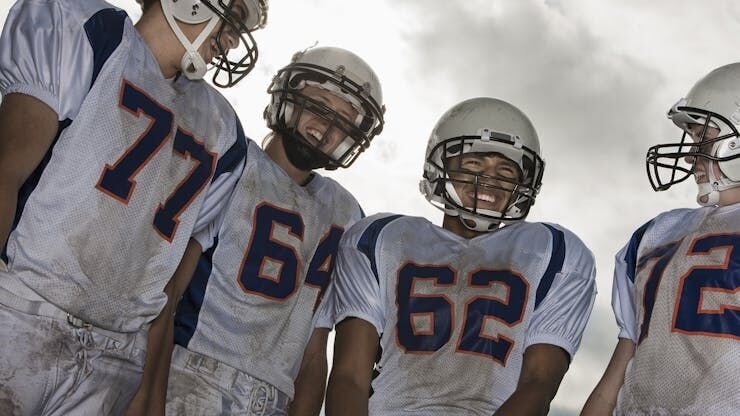On July 28, 2025, Shane Tamura entered a New York City office building that is home to the National Football League’s headquarters. He shot and killed four people and injured one other before killing himself.
In a note found in his wallet, he claimed he had , a degenerative brain condition believed to develop from repeated traumatic brain injuries. He .
CTE has received much attention over the past two decades as multiple NFL players have been diagnosed with the condition after their deaths. The ,” about a forensic pathologist named Dr. Bennet Omalu who documented the first case of CTE in an NFL player, also highlighted the issue.
People are also reading…
The gunman in the New York City shooting played high school football, but he did not play professionally. It is not known whether he had CTE.
I’m a who studies . Although people generally associate CTE with professional athletes, a growing body of research, including my own work, shows that adolescents and young adult athletes experience traumatic brain injuries that can have both short-term and long-term . In my view, young players and their families, as well as coaches, should pay attention to these emerging risks.

From traumatic brain injuries to CTE
At least are thought to experience a traumatic brain injury each year. The actual number may be higher, as many brain injuries are never diagnosed or treated.
Some people with a brain injury recover quickly. Others do not. Over half of people with a brain injury one year later. These include difficulties concentrating, memory problems and irritability, as well as physical concerns such as recurrent headaches and difficulties with balance. Many people who sustain a traumatic brain injury also report as they are recovering. Some report .
Although the link between is still being studied, many experts believe that the condition is caused not by a single, severe blow to the head but by .
It is not uncommon for former competitive athletes across a range of contact sports – not only because they remember the injuries or being diagnosed with a concussion, but also because that affect people with traumatic brain injuries and sometimes misuse alcohol, pain medications or other substances to cope with them.
However, there’s no way for someone to get a diagnosis for the condition while they are experiencing these symptoms. There is . Doctors generally diagnose it after an autopsy.

This image from surveillance video obtained by The Associated Press shows Shane Tamura outside a Manhattan office building on July 28 in New York.
Repeated brain injuries in youth sports
The focus on CTE has brought greater interest in the in general. Such injuries are common not only in professional athletes but also in . They are seen frequently as well.
In a study published in March 2025, my colleagues and I . We found that 75% said they had experienced a head injury before starting college. Almost 40% reported being diagnosed with at least one concussion, and just over half of those athletes experienced a loss of consciousness.
We also found that student athletes who had experienced head injuries were much more likely to be diagnosed with at least one psychiatric disorder in their lifetime. They were more likely to drink alcohol excessively and have a substance use disorder in their history. Greater symptoms of an alcohol use disorder were associated with having their first head injury at an earlier age, as well as having more head injuries, diagnosed concussions and losing consciousness from those injuries.
These troubling observations highlight the often overlooked in adolescents and young adults. Our study aligns with others that have found a relationship between – and it is among the first to look not only at self-reported symptoms but also at formal psychiatric diagnoses.
How exactly these cases might relate to CTE is unknown, but there are hints of a link: Researchers examining the records of 152 former contact sport athletes who died before age 30 . Family members described mental health symptoms in the majority of them, and alcohol and substance misuse were reported in approximately one-third.

In this 2017 photo, Ann McKee of Boston University addresses an audience on the school's campus about the study of NFL football player Aaron Hernandez's brain, projected on a screen behind in Boston.Ěý
Increasing safeguards for brain health in young athletes
While head injuries in youth sports were once met with a shrug, youth sports leagues are to the issue.
Studies suggest that in preseason training or between games can reduce young players’ head injury risks. Coaches of contact sports such as football and soccer often on identifying the signs and symptoms of head injuries and are given strategies to manage them.
, routinely available at many high school sporting events, are involved in sporting events for younger children as well. As first responders to athletic injuries, they are trained to assess symptoms of head injuries and , as part of a medical team, on when an athlete can return to play. Athletic trainers also may be well positioned to observe some of the mental health symptoms commonly seen after head injuries.
Following a head injury, parents and guardians should also keep an eye on their athlete. warrant a referral to a neurologist or mental health professional for additional assessment and treatment.
This article is republished from , a nonprofit, independent news organization bringing you facts and trustworthy analysis to help you make sense of our complex world. It was written by: ,
Read more:
The study was supported by a multi-project grant from the FY2015 Pennsylvania Commonwealth Universal Research Enhancement Program Formula Funding (PA CURE).


















